October 25, 2018
Our class had a trip to the Colorado Springs Fine Arts Center (FAC) and we went on a tour with Polly Nordstrand (Hopi) who is the Curator of the Southwest Art Collection at the FAC. We learned about the hierarchy of cultures, how the art world perpetuates elitism, how painting is considered the highest art form, how Native art was not considered “proper art” until the 1920s, and how there are imbalances in art history. When we viewed the Southwest Art Collection, we learned that before 1492/pre-contact, the Indigenous Peoples of what is now called the “Americas” already had trading systems in place. With the colonization of the “Americas” came the destruction of these trading systems and the enslavement/genocide of the Indigenous Peoples who were already there as well as the enslavement of the Indigenous Peoples from Africa. Colonization/westward expansion affected Indigenous Peoples, including their art, because it brought about political/economical transformation, the idea of “owning the land,” the commodification of food sources, new materials, cultural entrepreneurs who made culture part of the economy, and more. The white art market, especially in the Southwest, forced Native artists to make Native art how “Western eyes” saw and valued their artwork. For example, we learned that Native pottery was originally made for utilitarian purposes. Now, Native pottery in general is made to be aesthetically pleasing so it can be sold to art collectors/dealers/galleries and to be used for decorative purposes.
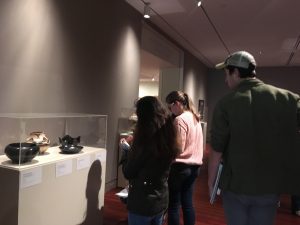
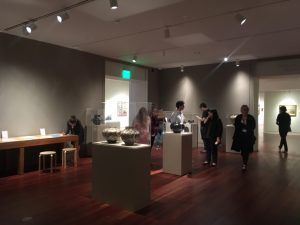
We also got to see and learn about two exhibits that were curated by Joy Armstrong (Curator of Modern and Contemporary Art at the FAC). We saw Virgil Ortiz’s (Cochiti Pueblo) “ReVOlution – Rise Against the Invasion” exhibit (October 6, 2018-January 6, 2019) and learned about the upcoming “In the Footsteps of My Ancestors” exhibit (October 27, 2018-February 10, 2019) by Jaune Quick-to-See Smith (Salish).
Virgil (https://virgilortiz.com) is the 2018 fall Andrew W. Mellon Artist-in-Residence for the FAC at the Colorado College. He has used different art mediums, including the traditional Cochiti Pueblo method of pottery making, to tell the widely unknown and untaught story of the Pueblo Revolt of 1680. He tells the story of this historic event while using science fiction, fantasy, contemporary art, modern technology, and Indigenous futurism components to engage larger audiences. The storyline dates from the time of the Pueblo Revolt in 1680 in New Mexico to 500 years into the future in 2180. Some of the characters in the story include the Aeronauts, Po’Pay, Translator and the Spirit World Army, Tahu and her army of Blind Archers, Runners, and Gliders.
“Set in the future of 2180, the pueblos are in chaos, the invasion of Native land continues, the scourge of war rages everywhere. The Aeronauts summon their fleet and prepare for extreme warfare against the invading Castilian forces. Desperately, the Aeronauts search for any remaining clay artifacts from the battlefields. They know that challenges and persecution will continue, so it is imperative to preserve and protect their clay, culture, language, and traditions from extinction.” (https://www.csfineartscenter.org/exhibits/virgil-ortiz/)
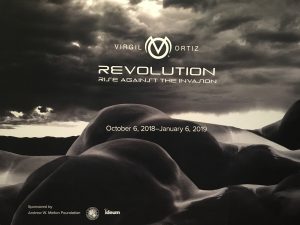
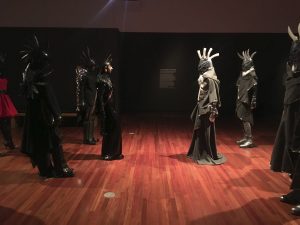
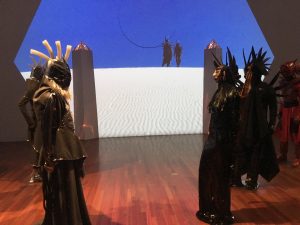
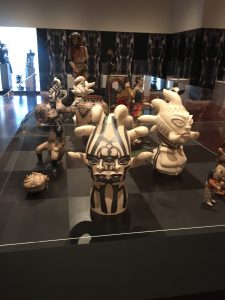
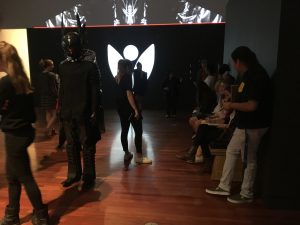
“Jaune Quick-to-See Smith (jaunequick-to-seesmith.com) is one of the U.S.’s finest indigenous talents and a late-career artist with extraordinary aesthetic, intellectual and curatorial achievements to her credit. Coming of age when Abstract Expressionism with its white male tenor dominated, Smith pushed back and developed a strong personal vision forged from belonging to two marginalized groups by birth (female and Native American) and one by choice (non-urban), aligning them more closely with the mainstream art world. This exhibition mines Smith’s cross-cultural experience and Salish-Kootenai identity and demonstrates the evolution of her lifelong aesthetic investigations in which she simultaneously questions and creates American history. In the Footsteps of My Ancestors examines themes that perennially recur in Smith’s work, including conflict, compassion, peace, the cycle of life, irony, and identity. The artist has always operated on a cusp – culturally, temporally, aesthetically, and from a gender perspective – which gives her work an attention-getting vitality, originality, and relevance. Her role in the shift toward deepening respect for Native American contemporary art cannot be understated, and her work is at once earthy, vibrant, sophisticated, and compassionate. Jaune Quick-to-See Smith: In the Footsteps of My Ancestors is organized by the Yellowstone Art Museum.” (https://www.csfineartscenter.org/exhibits/jaune-quick-to-see-smith/)